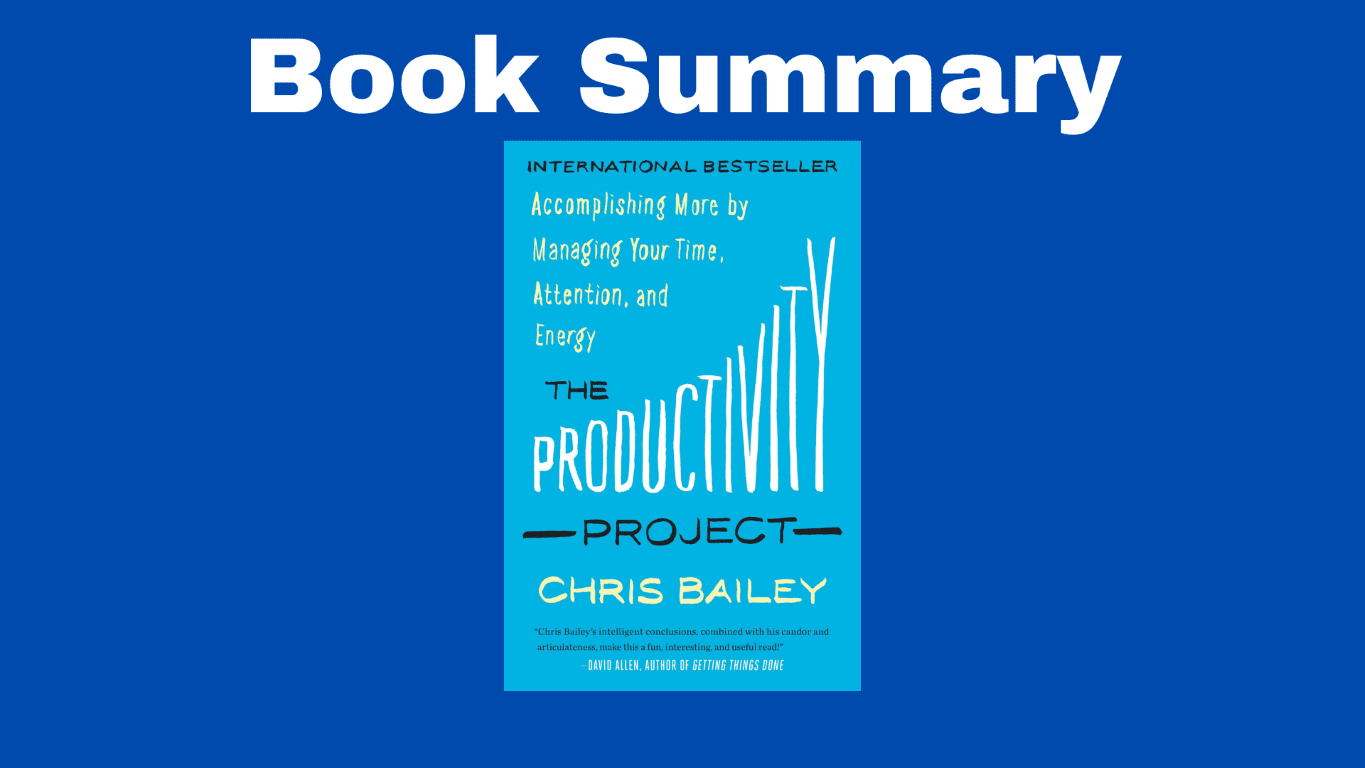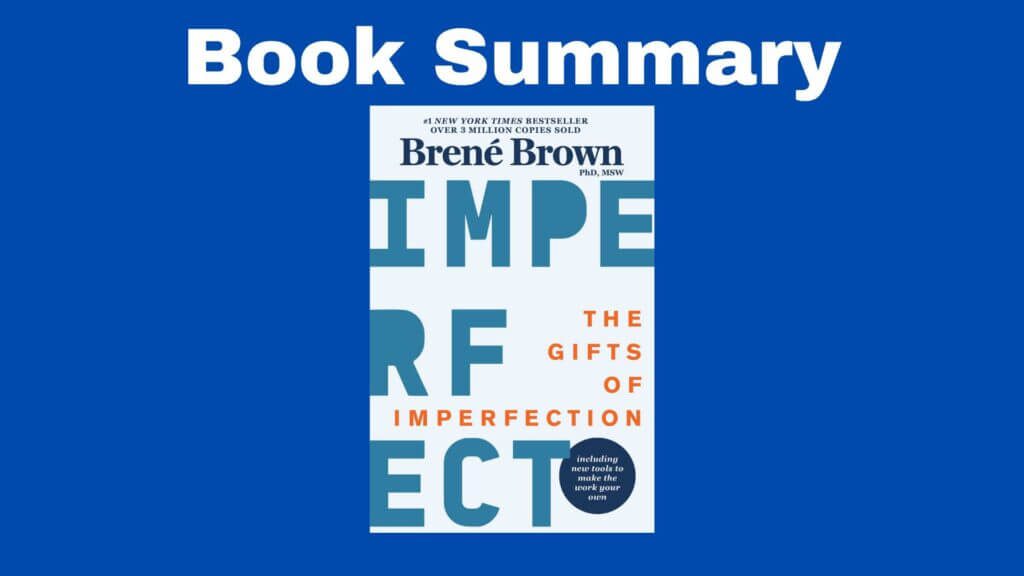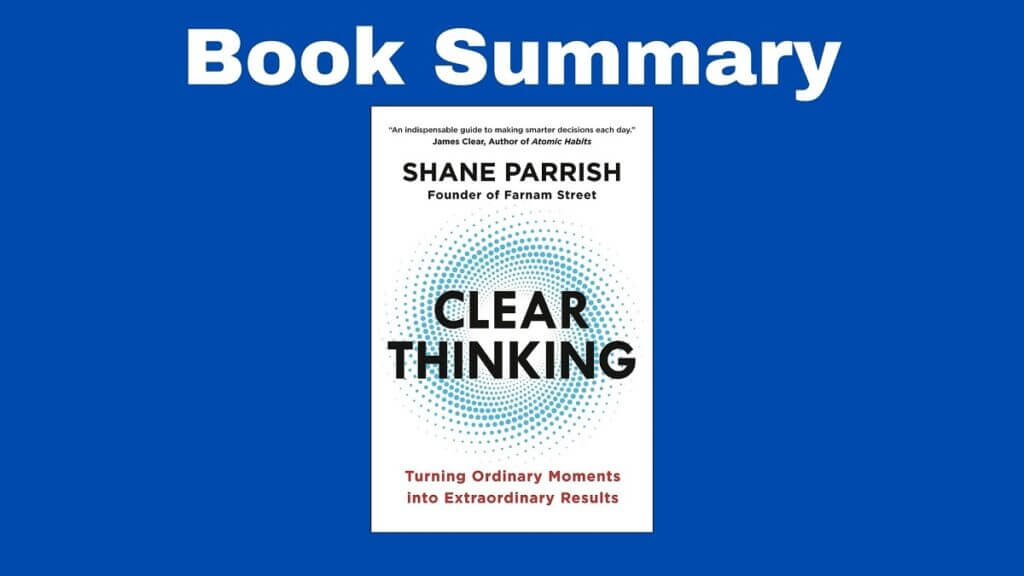The Book in Three Sentences
The Productivity Project is a summary of the experiments the author tried over the course of a year. Chris Bailey shares the lessons learned through those experiments, which include slowing down to be more deliberate, eliminating the non-essentials, and being productive even when he procrastinated. The book is a personal and compelling exploration of productivity with twenty-five of the best practices.
The Productivity Project Summary
Part I: Laying the Groundwork
1. Where to Start
The three parts of productivity are time, attention, and energy. Everyone likes the idea of productivity because it brings positive changes. But in reality, coming up with a system is a lot of work, so you have to have meaningful reasons and goals to be productive in order to be motivated.
Why do you want to be productive? What are your values? If you suddenly found yourself with extra time, how would you spend it? Do the activities that come to mind include community, relationships, or learning? If that’s the case, that means your goals are both deep and personal. With the use of effective productivity techniques comes free time for other activities. If your goals are in tune with your values, then it means coming up with a productivity system that works for you is worth it.
2. Not Every Task Is Created Equal
Some tasks let you accomplish more than others. These are called highest-impact tasks and once you’ve identified them, that’s where your attention, time, and energy should go. Take the time to differentiate the valuable tasks (planning out your week, automating repetitive tasks) from the not valuable (using social media or checking email repeatedly).
According to the “Pareto Principle”, 80% of some result comes from 20% of some cause. In other words, productivity isn’t about doing more things, it’s about doing the right things. Work smarter not harder.
3. Three Daily Tasks
To work with intention, follow the rule of three. At the beginning of each day, ask yourself: “which three things will I regret not doing at the end of the day?” They can be work-related, personal goals, or both, but they should align with your values and you should find them meaningful. You can write down the activities you do throughout the day to see if they align with your values and goals.
4. Ready for Prime Time
Observe how your energy changes during the day in order to identify your Biological Prime Time. You should work on the highest-impact activities during your BPT. Apart from managing your time, you should also manage your energy and attention.
Part Two: Wasting Time
5. Cozying Up to Ugly Tasks
Procrastination is human nature and everyone does it to a certain extent. We tend to procrastinate when what we have to do is boring, frustrating, difficult, unstructured, lacking in personal meaning, or not engaging. These are the six triggers of procrastination and explain why people prefer to watch Netflix rather than work on an important project. By identifying these triggers, you can make changes to a task to make it more inviting. For example, you can do your taxes in a cafe while trying out an exotic drink.
6. Meet Yourself… from the Future
You should get in touch with your “future self” to avoid giving him or her the same amount of work you’d give a stranger. Author Chris Bailey provides a series of tips to avoid this, such as saving money, eating healthy, learning new skills, reading more, or working out.
7. The Internet Is Killing Your Productivity
Since the internet can negatively affect your productivity, Chris Bailey suggests a series of tips so that you don’t waste time with technology. In order to reclaim your time and attention, disconnect from the internet when working on a demanding task, close all browser tabs, use airplane mode, and unsubscribe. When it comes to productivity, the internet should be a “nicety and not a necessity.”
Part Three: The End of Time Management
8: The Time Economy
Time became important in the 1800s during the industrial revolution. The first watches came out in the 1850s because back then, time meant money. Although managing time today is important, managing energy and attention is even more so.
9: Working Less
Busyness isn’t the same as productivity. Spending too much time on tasks means that you’re not spending your energy and attention well. Creating urgency for specific tasks motivates you and the task becomes less boring and difficult.
10 Energy Enlightenment
Time management can be useful, but to accomplish more, you should do the most important activities during your prime time. Your Biological Prime time should be a sacred moment that you protect at all costs.
11 Cleaning House
Maintenance tasks should be batched together and done all at once. In order to be productive, you can have a maintenance day when you water your plants, clean your house, do laundry, delete emails, cut your nails, or buy groceries Tackling several small activities at the same time feels great. Don’t be a perfectionist when it comes to maintenance tasks.
Part Four: The Zen of Productivity
12 The Zen of Productivity
Decrease the amount of time you invest in low-impact tasks, such as checking email. Increase the amount of time you spend on important activities so that you can focus on them with your full attention. Also, allow yourself to have zen-like moments by taking showers, going for a run, or reading in public spaces.
13 Shrinking the Unimportant
Low-impact tasks can be shrunk, delegated, or eliminated. Some of these include loading blog articles, answering emails, or attending meetings. These kinds of activities can be divided into two: the ones that drain your attention, such as answering email, or the ones that drain your time, such as meetings. Although you can’t eliminate all of these activities, you can control how you spend your time and attention with them.
14 Removing the Important
One of the best productivity hacks you can learn is to say the word no more often. For every low-impact task you say no to, say yes to a valuable activity. Focus on what’s essential and eliminate everything else. Ask yourself “How much would I be willing to pay in order to buy back one hour of my life?”. Consider hiring a virtual assistant (or VA) to help with the low-impact tasks.
Part Five: Quiet Your Mind
15. Emptying Your Brain
Keep notepads everywhere to capture ideas. Write down tasks to rest mentally and get organized. This is called a “brain dump” and it reduces stress, helps focus, and motivates you to do things. You can even write down the things that worry you and by externalizing the act of worrying, you limit it to a specific time. According to J. D. Meier, there are seven basic areas we invest our time, attention, and energy into
- Mind
- Body
- Emotions
- Career
- Finances
- Relationships
- Fun
At the same time, Chris Bailey expanded the mind “hot spot” into the following commitments
- Learning
- Meditation
- Reading
- Mindfulness
- Slowing down
- Making more attentional space between work and life
- Stress relief
16. Rising Up
In order to gain perspective, do a weekly review of everything you have done. You can see your accomplishments, as well as notice the areas that need improvement. By doing regular reviews, you can stay on track.
17 Making Room
Let your mind wander. Some ways in which you can let your mind run wild include exercising, meditating, taking a shower, listening to music, doing a creative hobby, praying, walking in nature, and spending time with the family.
Part Six: The Attention Muscle
18. Becoming More Deliberate
Although it’s important to let your mind wander, you should try to focus when working. This allows you to develop the “attention muscle” and over time, you’ll focus even more.
19. Attention Hijackers
As a way to focus more, you should avoid interruptions before they even happen. On average, it takes a person as many as 25 minutes to refocus after an interruption. Most distractions come from our phones, which means that we should turn off notifications, sounds, and buzzes. Author Chris Bailey suggests, the “20-second rule”, so by keeping negative distractions more than 20 seconds away from you, you’re likely to refrain from accessing in the first place.
20. The Art of Doing One Thing
Instead of multitasking, start single-tasking. This is great to build your “attention muscle”
21. The Meditation Chapter
Meditating makes you more productive and the best part is that meditating is less intimidating than most people think. According to Chris Bailey, these are the meditation myths:
- Meditation makes you less passive
- Meditation makes you less motivated
- Meditation will make you care less about your work
- Meditation takes too much time
- It’s too hard to get started
To meditate, you have to:
- Find somewhere quiet
- Sit upright
- Open or close your eyes
- Set a timer
- Focus on your breath
When your attention wanders (it will, especially at first) try to bring it back gently and concentrate on your breath.
Part Seven: Taking Productivity to the Next Level
22. Refueling
To have more energy:
- Eat more unprocessed food
- Stop eating when you’re full
23. Drinking for Energy
- Drink less alcohol
- Drink less sugary drinks
- Drink more water
- Drink deliberately
- Drink green tea instead of coffee
- Drink caffeine strategically (before a big workout, before presentations, before writing, before a research paper, for example).
24. The Exercise Pill
Exercising provides you with both energy and focus. Try to fit an exercise routine into your life.
25. Sleeping Your Way to Productivity
For every missed hour of sleep, you lose two hours of productivity. Try to sleep eight hours a day.
These are the changes Chris Bailey suggests for your sleeping routine:
- Create a nighttime ritual.
- Turn off electronics 2 or 3 hours before bed so that you avoid blue light.
- Take naps.
- Avoid coffee 8 to 14 hours before sleep.
- Think of your bedroom as a cave (a cool, quiet, and dark place).
Part Eight: The Final Step
26. The Final Step
The happier you are, the more productive you are, so be kind to yourself.
- Disconnect from productivity more often
- Recall three things you’re grateful for
- Journal about a positive experience you had
- Break tasks down
- Ask yourself for advice
- Reward yourself
- Know you can grow
- Create an accomplishment list
- Look at pictures of cute baby animals
Further Reading
Some of the books mentioned in The Productivity Project include:
- Work the System by Sam Carpenter
- Getting Things Done by David Allen
- I Know How She Does It and 168 Hours: You Have More Time Than You Think by Laura Vanderkam
- The Shallows: What the Internet Is Doing to Our Brains by Nicholas G. Carr
- Essentialism by Greg McKeown
- The Power of Habit by Charles Duhigg




